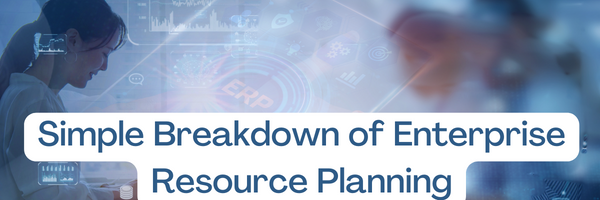
A Simple Breakdown of Enterprise Resource Planning
Enterprise Resource Planning (ERP) systems are essential tools that enable organizations to simplify their operations, increase their productivity, and maintain their competitive edge in today’s fast-paced market. The process of establishing an ERP system, on the other hand, can be complicated and filled with obstacles. This exhaustive book will delve into the complexities of the 6 Steps of Enterprise Resource Planning implementation, giving you a clear roadmap for a successful ERP integration along the way.

Establish Objectives
The beginning of your journey to adopt an ERP system can be marked by carefully defining your goals. What are some of the more specific objectives you hope to achieve with implementing the new ERP system? Whether it’s improving customer service, optimizing inventory management, or refining financial reporting, having clearly stated goals will serve as the North Star that guides your implementation strategy.
Make Sure You Choose The Appropriate System
Get started on a path of in-depth research if you want to make a well-informed decision. Research a number of different vendors, taking into account aspects such as scalability, options for customization, and characteristics that are specific to the industry. Both a project management system and an enterprise resource planning system, sometimes known as an ERP system, provide various benefits that increase organizational efficiency, decision-making, and the profitability of businesses.
The decision between the two must be made in light of the particular requirements and objectives of the company; however, it is common practice for companies to adopt both strategies in order to make full use of the benefits offered by each. Whatever you decide to choose, it must be best suited for your business in the long run.
Comprehensive Preparation And Drawings
When it comes to ERP system integration, the most important component is a solid implementation plan. Develop a comprehensive plan for the project that specifies dates, identifies important milestones, and allows roles and duties. Ensure that there will be as little disturbance as possible throughout the transition by having the ERP system customized to fit in smoothly with your existing business procedures.
Excellent Performance In Data Migration
Unfortunately, data migration is a phrase that is often disregarded. Ensure that the migration procedure receives your full and undivided attention. Make sure that all of your previously collected data is thoroughly cleaned, validated, and mapped exactly to the new ERP system. Data integrity is non-negotiable because it is the foundation of making well-informed decisions and carrying out corporate activities without interruption.
Instruction As Well As Strenuous Examination
The degree to which your staff is able to navigate the new ERP system will determine how successfully the ERP installation is carried out. Make sure that your team is well-versed in the use of the ERP system so that it can realize its full potential by providing them with extensive training.
In addition, comprehensive testing needs to be done in order to identify and resolve any bugs or inconsistencies in the system before it is put into production. This stage is essential to achieving a seamless transition and reducing the number of disturbances that occur during the process.
Going Live And Making Improvements Regularly
Now that the training and testing portions of your ERP system have been successfully completed, it is time to launch the system into production. Maintain a vigilant eye on its performance and consistently ask people for comments. Keep in mind that continuous improvement is not a post-implementation formality; rather, it is a continual effort that is a vital part of maximizing the benefits that your ERP solution can provide.
Conclusion
Your company may undergo a sea change if you were to adopt an enterprise resource planning (ERP) system successfully. This would herald a new era of greater productivity and sustainable expansion. You can clear the path for a smooth and successful ERP integration by sticking to this thorough guide’s six important phases with the utmost attention to detail, effectively tackling the difficulties that are most frequently encountered, and so on. Always remember that the cornerstones of long-term ERP success are ongoing improvement and user input. Embrace the potential of enterprise resource planning (ERP), and your company will open up new frontiers.